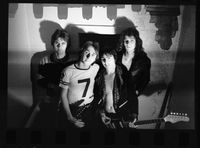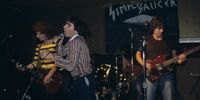In the House of Saucer: an Interview with Jesse Locke on His Upcoming Simply Saucer Biography, Heavy Metalloid Music
By James Lindsay
Jesse Locke is one of the great unsung heroes of Canadian music journalism. Through his years of work as a writer and editor for Weird Canada and AUX he has helped to expose countless bands and artists from across the country. In full disclosure, I am lucky to call him one of my best friends, so I was ecstatic when I heard that the Canadian-music-centric Eternal Cavalier Press had picked up his book, Heavy Metalloid Music, on the legendary Hamilton psychedelic proto-punks Simply Saucer. Simply Saucer, who despite never actually releasing a full album in their life as a band, have been having somewhat of a renaissance, and In The Red Records will be reissuing their posthumous LP, Cyborgs Revisited, later this year. Books like this—that document lesser known but still influential Canadian artists—are more important than ever to help preserve our culture before it’s forgotten. I wanted to ask Jesse a few questions to help introduce Heavy Metalloid Music and was even lucky enough to get an early excerpt from the book recanting how dangerous the Hamilton music scene could be in the late 1970s.
James Lindsay: How did you come to discover Simply Saucer and what led you to write this book?
Jesse Locke: Like so many other things I hold dear, I can thank my friend Craig Fahner for first playing me Simply Saucer's Cyborgs Revisited years ago. Their song "Illegal Bodies" flipped my wig immediately, sounding like a weird Canadian doppelgänger of the Velvet Underground's "Sister Ray." Simply Saucer were total outsiders in 1973, creating their own sci-fi escapism with a bizarro world version of their book, comic, and record collections. I'll never get tired of their music, and after reading more about the band's story in Liz Worth's Treat Me Like Dirt (which takes its title from the chorus of their song "Bullet Proof Nothing") I became completely obsessed.
I've written hundreds of artist profile articles over the years, and always dreamed of spinning one of them into a book-length biography. Shortly before starting work on this project, I was assigned to write the liner notes for a reissue of the Nihilist Spasm Band's first album, and had a blast interviewing them while stretching out with their history. I decided Simply Saucer would be the perfect candidate for a bio and went up to frontman Edgar Breau after seeing them play live for the first time in February 2013 (on a cool mixed bill with Lido Pimienta and The Highest Order). Edgar was really into the idea, and the rest is ongoing history.
James Lindsay: What did you learn about 1970s Hamilton while researching the book?
Jesse Locke: I learned about the street gang activity of Kenilworth Avenue, where Edgar lived in the band's jamspace in a broken down, black mold filled storefront. I learned about Pink Floyd playing at Ivor Wynne stadium in 1975, on the same day that Simply Saucer recorded the live side of Cyborgs Revisited on the roof of Jackson Square mall. I learned about larger than life characters like Gary Pig Gold, Imants Krumins, Bruce "The Mole" Mowat, Bob and Daniel Lanois, The Forgotten Rebels, and The Chessmen, all of whom share a Saucer connection. I learned about supernatural rituals to ward off evil spirits, and playing all four sides of Metal Machine Music at once. I learned about life working in a steel mill or a jail, the Velvet Underground concert at McMaster University in 1966, and The Hilarious House of Frightenstein.
James Lindsay: What have the members of Simply Saucer been up to recently?
Jesse Locke: A lot! After breaking up in 1979 they reformed in 2006, released a new album in 2008, then an EP in 2014. They've recently been playing with a CanCon superstar line-up featuring Glenn Milchem of Blue Rodeo on drums and Mike Trebilcock of The Killjoys on guitar and skull theremin. I've contributed to the release of an archival 7" from Mammoth Cave Recording Co., an incredible 2LP set of unreleased rarities from Logan Hardware/Galactic Zoo Archive, and an expanded 40th anniversary edition of Cyborgs Revisited coming later this year from In The Red. On top of my book, there's also a Simply Saucer documentary from director Gregory Bennett that will hopefully see the light of day soon. Edgar is currently recording a new solo album with Gaven Dianda of Thee Gnostics/Saffron Sect, and Simply Saucer continue to crank out heavy metalloid music as only they can.
"The Fall of the House of Saucer," from Heavy Metalloid Music: The Story of Simply Saucer.
Forty-One Ferguson Avenue South was the only house on an unpopulated Hamilton stretch with train tracks running down the street outside its front door. The grubby brown and red exterior of this dilapidated dwelling that Simply Saucer called home can be seen in the Super 8 footage of their “Bullet Proof Nothing” video. Shadowy glimpses of the staircase, bedrooms and a mirrored dresser appear in the band’s scant collection of photos.
Your CanLit News
Subscribe to Open Book’s newsletter to get local book events, literary content, writing tips, and more in your inbox
Otherwise, the tales of illicit activities at the notorious (now demolished) ‘Saucer House’ only remain in hazy memories and hyperbolic stories. These continue to circulate among those who were there, those who wished they were there, and those glad they weren’t. Yet anyone with roots in Steeltown will attest that the organized slime oozing down into Ferguson Avenue during the band’s tenancy dates back much further. Today, these stories sound like they were ripped from the pages of S.E. Hinton and brought into bone-chilling reality.
“I started hearing things in the late ’60s when all of the frats were around,” says photographer and Saucer House regular Pete Day. “There was the blue frat, the brown frat, and the green frat. I remember being in high school and getting warnings that they’d be going at it that night. They’d have rumbles scheduled in a park somewhere.”
“You couldn’t even walk down the street if you looked different in Hamilton, which was supposedly a pretty cool and open-minded town,” says the band’s label head Gary Pig Gold. “If you wore flares that was fine, but if you had tight pants or short hair, you would get beaten up. It could be a really scary place.”
“It was truly a different story when gangs like the Sherman Boys started cropping up,” adds bassist Kevin Christoff. “In the late ’70s when we were playing, it was out and out war.”
At the time of the recording sessions for the band’s debut 7” released by Gold’s label Pig Records, the near-nightly debauchery at the Saucer House had been going strong for several years.
“When I first visited in early ’77, Saucer wasn’t gigging much at all,” says Gold. “The band members and a few friends would have been coming back at the end of the night, but it wasn’t the party house that legend had it become in ’78 or ’79. At first it was just the place where people lived and rehearsed. A few times, people who drove the train on the tracks out front would stop to come inside and have a beer.”
Thanks to the dedication of Gold’s journal writing, an infamous incident can be reenacted from his detailed entry on March 4th, 1978. That night, two sinister strangers drove up in a white, windowless van and banged on the front door asking for drummer Don Cramer. Someone hollered that he wasn’t home, yet the duo continued to linger outside like vultures circling an animal on its last legs.
Fearing that something was about to go down, frontman Edgar Breau was awakened with a start. With bleary eyes and a head pounding, he bounded downstairs to frantically tuck the band’s treasured instruments under the basement’s trap door.
Moments later, the men—now with nylon stockings on their heads—kicked in the side door and zipped a blade to Breau’s throat. Saucer’s rehearsal space bounty was safe, yet the thugs still made off with a pawnshop bonanza of nearly $3,000 in turntables, receivers, and speakers.
“I was drunk and passed out when I heard someone shouting for me to get up,” Breau shivers. “I raced out of bed, hid our guitars, and came back upstairs to guys with nylons on their heads holding machetes. One of them put a knife to my neck and threatened to kill me. He threw me against the wall and broke a hole, and then they stole all of our stereo equipment.”
Breau shares similar stories of uninvited guests stopping by to collect Cramer, one of whom (known to the band members as Bayla) met his fate in a shootout with local law enforcement years later. The typical response to these surprise visits was to turn off the lights and hide behind couches or inside closets. However, one hair-raising pop in during an afternoon practice offered the band zero time to react.
“One day we were visited by these scary guys who looked like the Sopranos because of the way they were dressed in suits,” says Breau. “I don’t know how they got inside, but they came straight downstairs and we stopped playing immediately. I remember hoping that one of us knew them. Don was freaked out, and he went off with them. I don’t know if they were collecting money or what was happening, but it was seriously frightening.”
Cramer recalls yet another home invasion resulting in a bloody brawl between him, band roadie Gripper, and a larger group of muscle-bound goons.
“I had $5,000 of stereo equipment in my bedroom,” says Cramer. “I was an absolute audiophile freak back then! Sure enough, one day some members of a gang broke in. Gripper and I were fighting against five of them. They stabbed me with a kitchen fork right below my eyeball!”
Another inevitability is that the hellraising activities surrounding the band would bleed into the burgeoning punk scene. Hometown heroes Chris Houston and Mickey DeSadist of The Forgotten Rebels were no strangers to the Saucer House, but Breau can only recall one appearance of Steven Leckie (a.k.a. Nazi Dog), frontman of Toronto’s notoriously violent Viletones. On that fateful night, Leckie didn’t even make it inside the front door.
“One of our roadies made the brilliant decision to steal a bottle of whiskey from their road crew,” Breau laughs. “A while later, Leckie showed up with an axe, joined by a few other ruffian types. We were sitting on the porch calling them on, and Don had a 12-foot African spear that he kept around. My girlfriend Linda was trying to be the peacemaker, but Leckie was yelling ‘We want our bottle back!’ We’d reply ‘Come and get it!’ You know they never came and got it.”
The views expressed in the Writer-in-Residence blogs are those held by the authors and do not necessarily reflect the views of Open Book: Toronto.
The views expressed in the Writer-in-Residence blogs are those held by the authors and do not necessarily reflect the views of Open Book.
James Lindsay has been a bookseller for more than a decade. He is also co-owner of Pleasence Records in Toronto, a record label specializing in post-punk, odd-pop and avant-garde sound pieces.




